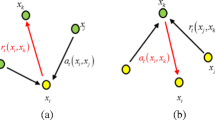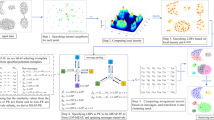Abstract
Recently, as one of the most popular exemplar-based clustering algorithms, affinity propagation has attracted a great amount of attention in various fields. The advantages of affinity propagation include the efficiency, insensitivity to cluster initialization and capability of finding clusters with less error. However, one shortcoming of the affinity propagation algorithm is that, the clustering results generated by affinity propagation strongly depend on the selection of exemplar preferences, which is a challenging model selection task. To tackle this problem, this paper investigates the clustering stability of affinity propagation for automatically selecting appropriate exemplar preferences. The basic idea is to define a novel stability measure for affinity propagation, based on which we can select exemplar preferences that generate the most stable clustering results. Consequently, the proposed approach is termed stability-based affinity propagation (SAP). Experimental results conducted on extensive real-world datasets have validated the effectiveness of the proposed SAP algorithm.











Similar content being viewed by others
Notes
Exemplar is a data point that best represents a cluster. It is also termed cluster center or prototype in the literature of data clustering.
References
Akaik H (1974) A new look at statistical model identification. IEEE Trans Autom Cont 19:716–723
Asuncion A, Newman D (2007) UCI machine learning repository, http://www.ics.uci.edu/~mlearn/MLRepository.html
Bandyopadhyay S (2011) Multiobjective simulated annealing for fuzzy clustering with stability and validity. IEEE Trans Syst Man Cybern Part C Appl Rev 41(5):682–691
Ben-David S, von Luxburg U (2008) Relating clustering stability to properties of cluster boundaries. In: COLT 2008, pp. 379–390
Ben-David S, Pal D, Simon HU (2007) Stability of \(k\)-means clustering. In: Learning Theory, Lecture Notes in Computer Science 2007, vol 4539, pp 20–34
Bozdogan H (1987) Model selection and Akaike’s information criterion (AIC): the general theory and its analytical extensions. Psychometrika 52:345–370
Ding S, Ma G, Shi Z (2013) A novel self-adaptive extreme learning machine based on affinity propagation for radial basis function neural network. Neural Computing and Applications (in press)
Dueck D, Frey BJ, Jojic N, Jojic V, Giaever G, Emili A, Musso G, Hegele R (2008) Constructing treatment portfolios using affinity propagation. In: RECOMB, pp. 360–371
Frey BJ, Dueck D (2007) Clustering by passing messages between data points. Science 315:972–976. http://www.psi.toronto.edu/index.php?q=affinity%20propagation
Givoni IE, Chung C, Frey BJ (2011) Hierarchical affinity propagation. In: UAI, pp 238–246
Givoni IE, Frey BJ (2009) A binary variable model for affinity propagation. Neural Comput 21(6):1589–1600
Givoni IE, Frey BJ (2009) Semi-supervised affinity propagation with instance-level constraints. In: AISTATS, pp. 161–168
Guo P, Jiang Z, Lin S, Yao Y (2012) Combining LVQ with SVM technique for image semantic annotation. Neural Comput Appl 21:735–746
Hansen MH, Yu B (2001) Model selection and the principle of minimum description length. J Am Stat Assoc 96:746–774
Hu X, Xu L (2003) A comparative study of several cluster number selection criteria. In: Intelligent data engineering and automated learning 2003, pp 195–202
Huang TH, Cheng KY, Chuang YY (2009) A collaborative benchmark for region of interest detection algorithms. In: CVPR, pp 296–303
Hull JJ (1994) A database for handwritten text recognition research. IEEE Trans Pattern Anal Mach Intell 16(5):550–554
Kschischang FR, Frey BJ, Loeliger HA (2001) Factor graphs and the sum-product algorithm. IEEE Trans Inf Theory 47(2):498–519
Kuncheva LI, Vetrov DP (2006) Evaluation of stability of k-means cluster ensembles with respect to random initialization. IEEE Trans Pattern Anal Mach Intell 28(11):1798–1808
Lange T, Braun ML, Roth V, Buhmann JM (2002) Stability-based model selection. In: NIPS 2002, pp 617–624
Lange T, Roth V, Braun ML, Buhmann JM (2004) Stability-based validation of clustering solutions. Neural Comput 16:1299–1323
LeCun Y, Bottou L, Bengio Y, Haffner P (1998) Gradient-based learning applied to document recognition, http://yann.lecun.com/exdb/mnist/. Proceedings of the IEEE 86(11):2278–2324
von Luxburg U (2009) Clustering stability: an overview. Found Trends Mach Learn 2(3):235–274
MacQueen J (1967) Some methods for classification and analysis of multivariate observations. In: Proceedings. of the Fifth Berkeley symposium on mathematical statistics and probability, University of California Press, California, vol 1, pp 281–297
Rakhlin A, Caponnetto A (2006) Stability of \(k\)-means clustering. In: NIPS 2006, pp 1121–1128
Rinaldo A, Singh A, Nugent R, Wasserman L (2012) Stability of density-based clustering. J Mach Learn Res 13:905–948
Roth V, Braun ML, Lange T, Buhmann JM (2002) Stability-based model order selection in clustering with applications to gene expression data. In: Proceedings of ICANN 2002, pp 607–612
Shang F, Jiao L, Shi J, Wang F, Gong M (2012) Fast affinity propagation clustering: a multilevel approach. Pattern Recogn 45:474–486
Strehl A, Ghosh J (2002) Cluster ensembles—a knowledge reuse framework for combining multiple partitions. J Mach Learn Res 3:583–617
Sumedha ML, Weigt M (2008) Unsupervised and semi-supervised clustering by message passing: soft-constraint affinity propagation. Eur Phys J B 66:125–135
Tarlow D, Zemel RS, Frey BJ (2008) Flexible priors for exemplar-based clustering. In: UAI, pp 537–545
Verma R, Wang P (2007) On detecting subtle pathology via tissue clustering of multi-parametric data using affinity propagation. In: ICCV, pp 1–8
Vinh NX, Epps J, Bailey J (2009) Information theoretic measures for clusterings comparison: Is a correction for chance necessary? In: ICML 2009, pp 1073–1080
Wang CD, Lai JH (2011) Energy based competitive learning. Neurocomputing 74:2265–2275
Wang CD, Lai JH, Huang D (2011) Kernel-based clustering with automatic cluster number selection. In: ICDM Workshops 2011, pp 293–299
Wang CD, Lai JH, Suen CY, Zhu JY (2013) Multi-exemplar affinity propagation. IEEE Trans Pattern Anal Mach Intell 35(9):2223–2237
Wang CD, Lai JH, Zhu JY (2012) Graph-based multiprototype competitive learning and its applications. IEEE Trans Syst Man Cybern C Appl Rev 42(6):934–946
Xiao J, Wang J, Tan P, Quan L (2007) Joint affinity propagation for multiple view segmentation. In: ICCV, pp 1–7
Xu B, Hu R, Guo P (2013) Combining affinity propagation with supervised dictionary learning for image classification. Neural Comput Appl 22:1301–1308
Xu L, Krzyzak A, Oja E (1993) Rival penalized competitive learning for clustering analysis, RBF net, and curve detection. IEEE Trans Neural Netw 4(4):636–649. doi:10.1109/72.238318
Yang D, Guo P (2011) Image modeling with combined optimization techniques for image semantic annotation. Neural Comput Appl 20:1001–1015
Zhang X, Furtlehner C, Sebag M (2008) Data streaming with affinity propagation. In: ECML, pp 628–643
Zhao ZQ, Gao J, Glotin H, Wu X (2010) A matrix modular neural network based on task decomposition with subspace division by adaptive affinity propagation clustering. Appl Math Model 34:3884–3895
Zhou P, Li D, Wu H, Cheng F (2011) The automatic model selection and variable kernel width for RBF neural networks. Neurocomputing 74:3628–3637
Acknowledgments
This work was supported by NSFC (Grant No. 61170136, 61373101 and 71101096), NSFC-GD Project: U1201252, Research Training Program of Sun Yat-sen University (Grant No. 13lgpyyd03), Pilot Program of SYSU-CMU Shunde International Joint Research Institute.
Author information
Authors and Affiliations
Corresponding author
Rights and permissions
About this article
Cite this article
Chen, DW., Sheng, JQ., Chen, JJ. et al. Stability-based preference selection in affinity propagation. Neural Comput & Applic 25, 1809–1822 (2014). https://doi.org/10.1007/s00521-014-1671-4
Received:
Accepted:
Published:
Issue Date:
DOI: https://doi.org/10.1007/s00521-014-1671-4




